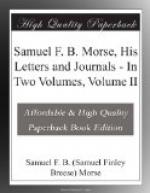This first rude instrument was carefully preserved by the inventor, and is now in the Morse case in the National Museum at Washington. A reproduction of it is here given.
I shall omit certain technical details in the inventor’s account of this first instrument, but I wish to call attention to his ingenuity in adapting the means at his disposal to the end desired. Much capital has been made, by those who opposed his claims, out of the fact that this primitive apparatus could only produce a V-shaped mark, thus—
__ __ _ \/|__| |/\/ |/\/|__/
—and not a dot and a dash, which they insist was of later introduction and by another hand. But a reference to the sketches made on board the Sully will show that the original system of signs consisted of dots and lines, and that the first conception of the means to produce these signs was by an up-and-down motion of a lever controlled by an electro-magnet. It is easy to befog an issue by misstating facts, but the facts are here to speak for themselves, and that Morse temporarily abandoned his first idea, because he had not the means at his disposal to embody it in workable form and had recourse to another method for producing practically the same result, only shows wonderful ingenuity on his part. It can easily be seen that the waving line traced by the first instrument—thus,
__ __ _ \/|__| |/\/ |/\/|__/ —can be translated by reading the lower part into
a i u . — . . . . — of the final Morse alphabet.
The beginnings of every great invention have been clumsy and uncouth compared with the results attained by years of study and elaboration participated in by many clever brains. Contrast the Clermont of Fulton with the floating palaces of the present day, the Rocket of Stephenson with the powerful locomotives of our mile-a-minute fliers, and the hand-press of Gutenberg with the marvellous and intricate Hoe presses of modern times. And yet the names of those who first conceived and wrought these primitive contrivances stand highest in the roll of fame; and with justice, for it is infinitely easier to improve on the suggestion of another than to originate a practical advance in human endeavor.
Returning again to Morse’s own account of his early experiments I shall quote the following sentences:—
“With this apparatus, rude as it was, and completed before the first of the year 1836, I was enabled to and did mark down telegraphic, intelligible signs, and to make and did make distinguishable sounds for telegraphing; and, having arrived at that point, I exhibited it to some of my friends early in that year, and among others to Professor Leonard D. Gale, who was a college professor in the University. I also experimented with the chemical power of the electric current in 1836, and succeeded, in marking my telegraphic signs upon paper dipped in turmeric and solution of the sulphate of soda (as well as other salts) by passing the current through it. I was soon satisfied, however, that the electro-magnetic power was more available for telegraphic purposes and possessed many advantages over any other, and I turned my thoughts in that direction.




